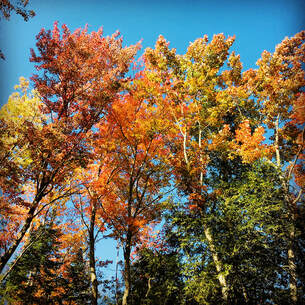 We know that leaves change color in the fall and then fall off the trees. We know that this is a sign that the tree is going to “sleep” because winter is coming. But what is the actual science behind leaves changing color? Read on to find out... During the spring and summer, trees have green leaves because of the chlorophyll within the leaves’ cells. Chlorophyll is a key player in photosynthesis because it traps light energy from the sun, which is then used to produce food for tree growth. Leaves always have many other colored pigments within them (some of the pretty colors we see in the fall), but during the spring and summer, there is so much chlorophyll within the leaves that the green “masks” the other colors. In the fall, trees prepare for winter. Due to the lack of sunlight during the winter, it is not “energy efficient” for the trees to retain their leaves. With little or no sunlight, they cannot produce food (or produce very little) through photosynthesis so they essentially have no use for their leaves. In anticipation of winter, trees reabsorb nutrients, including chlorophyll, from the leaves. The chlorophyll is broken down and the green color disappears, revealing the orange and yellow pigments. A little more complicated science and the tree drops their leaves. This helps the tree conserve water and energy. Evergreen trees lose their needles too, just not all at once. New needles grow every year, and needles only live so long (2-5 years). So, older needles will often shed in the fall. It is not as noticeable as deciduous trees however, because there are still likely many green needles remaining on the tree. Our world and the science behind things is quite amazing, isn’t it?
1 Comment
 Do you throw away food scraps or waste including fruit and vegetable peels and rinds? What about lawn clippings or leaves that you must rake every fall? Do you have a garden at your home that would benefit from natural fertilizer? Then composting may be for you! Composting can be accomplished many ways and provides countless benefits. Composting is not only beneficial to the environment, but it can help you out too! It reduces your need for chemical fertilizers by providing nutrients your soil and plants need and is easy and cheap for you to do. By composting rather than throwing away your waste, you also help to reduce methane emissions from landfills and lower your carbon footprint. While there are many different methods to compost, the basics remain the same for all. Your compost must be properly composed of brown material, green material, water, and oxygen. Brown materials, which provide carbon, include things like dry leaves, wood chips, and cardboard. Green materials, which provide nitrogen, are things like vegetable and fruit scraps, eggshells, grass clippings, and garden/yard waste. The water and oxygen help break down the organic matter. You should not put dairy products, fats, meats, pet wastes, or plant material that is diseased or has been treated with chemical pesticides in your compost. Aim to have your compost pile made up of equal parts of brown and green materials, and no more than 2-parts green to 1-part brown. Compost options include closed bins, tumblers, pit composting, open bins, piling, and vermicomposting. If you want to go with the easiest route, piling, meaning creating a heap of compost, takes essentially no effort. If you prefer your compost more hidden, a plastic closed bin or tumbler, or even an open bin constructed of wood can provide a barrier to the unsightly materials. If you prefer to entirely hide the compost, pit composting is for you. Just dig a hole and bury your waste (but this makes using that compost on your garden beds essentially impossible). Finally, if you do not have access to a yard, vermicomposting can be done right in your kitchen (really!). While a little more feeble and harder to properly maintain, vermicomposting uses the energy of worms to compost your scraps. Whatever method you choose, composting is a good choice! There is a myriad of resources online (including https://www.epa.gov/recycle/composting-home) and many books about the topic to further read up on. Antrim Conservation District is also available to answer your questions, and is available by phone at (231)533-8363 or email at antrimcd@macd.org. 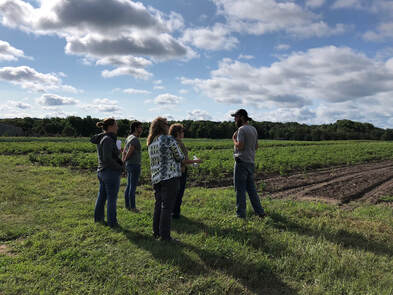 By: McKenzie Fox, Conservation Program Assistant Farmers young and old know the importance of soil to their crops and livelihood. Soils hold and provide the nutrients and water for the plants they grow, and healthy soils are the foundation for a healthy farm. Soil is a living ecosystem with bacteria, fungi, and microbes, and for the soil to continue to do its job of producing crops, it is important that we ensure the ecosystem is well-functioning. Healthy soils lead to increased production, increased profits, and natural resource protection (healthy soils hold more water, decrease flooding, provide more nutrients to crops, and help crops resist disease and pests) according to the Natural Resources Conservation Service (NRCS). Given that 95% of our food is directly or indirectly produced on our soils, soil health does not just affect farmers. It affects all of us. Every year, the Antrim and Kalkaska Conservation Districts (ACD & KCD) host a soil health field day. This year, the event will take place on July 25th at Iott Seed Potato Farm in Kalkaska, highlighting their 3-year cover crop trial. Field day discussions will also include an intro to the Iott Farm Story, soil health impacts on crops, attracting beneficial insects on the farm, composting, and the Michigan Agriculture Environmental Assurance Program (MAEAP). The event will begin with day-of registration at 9:00am and end with an ice cream social at 3:30pm. We are excited for this very informative and fun event! Pre-registration is encouraged and can be done on KCD website at kalkaskaconservation.org or by calling the office at (231)258-3307. Registration is $10 per person and includes a locally sourced lunch. You must pre-register by July 22nd to guarantee your lunch. For more information on ACD and/or to subscribe to ACD’s newsletter, visit our website at antrimcd.com, call us at (231)533-8363, or stop by our office at 4820 Stover Rd. in Bellaire. For more information on KCD, visit their website at kalkaskaconservation.org, call them at (231)258-3307, or stop by their office at 406 South Cedar St., Suite A in Kalkaska. Read more about soil health at http://www.nrcs.usda.gov.  By: McKenzie Fox, Conservation Program Assistant With spring officially here, it’s time to hit the trails! Antrim County is home to a plethora of beautiful trail systems, some of which Antrim Conservation District (ACD) manages. ACD has a forester, as well as a parks and trails coordinator, both of which help to maintain county property and trail systems. With the abundance of trails around the county, you may have not even heard of some of them! Maybe you are looking for a gorgeous stroll on the bay in which case you would want to visit Antrim Creek Natural Area. Don’t want to travel far from Bellaire? Head down to the Cedar River Natural Area, which offers the beauty and quietness of the forest less than a mile from town. Looking for a quick easy hike? Try Mohrmann Park. Want to walk on rolling dunes? Try Torch Bay Nature Preserve. These are only a few of the many wonderful trail options around the county! ACD will host a variety of events this month to take advantage of our beautiful trail systems. Continuing with our weekly event Trail Tuesday, join ACD staff for a hike at the Cedar River Natural Area during your lunch break every Tuesday. We meet at the Fairground Trailhead at noon and do a short hike that lasts approximately 30 min. At the end of the month, on May 28th, we will do a special Trail Tuesday event at Mohrmann Natural Area (and will not do one that day at Cedar River). We will meet at the trailhead off Intermediate Lake Road at noon for a short, easy hike (less than 1 mile). Finally, on May 25th, to kick off the Petoskey Stone Festival, join us for a trail 5k at Barnes Park. You can run, jog, or walk your way through the beautiful trails with a race time starting at 8:30am. Registration can be completed online at antrimcd.com or in person on the day of the race starting at 7:30am. We hope you get a chance to go exploring on one of Antrim County’s beautiful trails this spring. From Glacial Hills to Grass River to Cedar River to Barnes Park and more, we are certainly lucky to have such an abundance of places to explore. This is the time to go see wildflowers and wildlife as the forest re-awakens after a long winter. Happy trail-going, friends!  By: Wendy Warren, District Manager Do you have old light bulbs, paints, electronics, cleaners, or other items sitting around your house that you are just waiting to get rid of?? These materials, classified as Household Hazardous Waste, are “leftover household products that can catch fire, react, or explode under certain circumstances, or that are corrosive or toxic” (EPA). Proper storage and disposal are important for not only the safety of ourselves and others, but also for the protection of our environment. Thankfully, many areas, including our own, provide disposal programs which keep these substances out of landfills which can leach into the groundwater. Antrim Conservation District will host HHW collection days in Elk Rapids on May 18th (tires only) and June 15th (no tires), Bellaire on August 3rd, and Mancelona on September 14th. Each household of Antrim county may bring up to 100 lbs. of household hazardous waste free of charge. Typical waste accepted at these events includes pesticides, fertilizers, cleansers, poisons, auto fluids, used oil, batteries, fluorescent bulbs, computers, T.V.s, and oil-based paints. Scrap tires will also be accepted (up to 10 free per household) and will not count towards the 100 lb. limit. Waste weighing more than 100 lbs. will be charged a fee of $1.00 per pound. Additionally, latex paint will be charged a separate fee of $1.00 per gallon. Because it is not hazardous, homeowners are encouraged to mix latex paint with sawdust or kitty litter, let it solidify then place it in their regular garbage, rather than bringing it to the household hazardous waste event. The cost to taxpayers for these events is kept to a minimum by utilizing volunteers to help unload waste from vehicles. Antrim Conservation District is seeking businesses who would like to display their logo or sign in exchange for volunteer help. Non-profits in the area will receive a donation from the Antrim Conservation District in exchange for volunteer assistance (volunteers over 18 years of age). Call (231) 533-8363 ext. 1 to register as a volunteer or to get more information. For more information about ACD’s HHW collection days, click here, stop by our office at 4820 Stover Rd. in Bellaire, or call us at (231)533-8363. Kalkaska Conservation District will host their HHW collection day on July 20th. See their website at www.kalkaskaconservation.org or call their office at (231) 258-3307 for more information. Source: https://www.epa.gov/hw/household-hazardous-waste-hhw By: McKenzie Fox, Conservation Program Assistant
There may still be snow on the ground in Antrim and Kalkaska counties, but the sunshine and birds chirping give signal that spring is coming, which means it is time to place your tree sale orders with your county’s conservation district! Both Antrim and Kalkaska Conservation Districts have released their tree sale catalogs and are taking orders now. You can find the catalogs and order forms at antrimcd.com and kalkaskaconservation.org, or by visiting the respective office locations. Both conservation districts are taking orders online or through the paper order forms. Order early to secure your trees as they are first come first served at ACD, and orders are only guaranteed till April 1st at KCD (based on availability after that date). Order pick-up will be on April 26th and 27th. There are numerous options to choose from that fit the needs of individual landowners and their property’s needs. Recommendations for wet soils include red osier dogwood, river birch, white cedar, and red mulberry. If you have dry soils, there are oaks, pines, spruces, ninebark, and Chinese chestnut. Maybe you are looking for trees or plants that can serve as windbreaks? We have you covered with white cedar, Norway spruce, blue spruce, red osier dogwood, highbush cranberry, and American hazelnut. Wildlife food and cover? ACD’s tree selection this year include everything from oaks to spruces to hybrid poplar, white cedar, and more. ACD is also selling apple trees, and KCD is offering tree packages and seed mixes that serve specific purposes. Tree protection, i.e, tree tubes and stakes, are also being offered by both Conservation Districts to protect your investment. See the respective catalogs for more information. Antrim Conservation District will also be hosting a tree selection and planting workshop on Monday, March 18th from 6pm-7:30pm at their office, 4820 Stover Rd. in Bellaire. Learn about what trees would fit well with your property’s needs and how to plant them. Attendees will receive a 10% discount on their spring tree order from ACD. Please RSVP to McKenzie (mckenzie.fox@macd.org or 231-533-8363 x4) by Friday, March 15th. For more information on ACD and/or to subscribe to ACD’s newsletter, visit our website at antrimcd.com, call us at (231)533-8363, or stop by our office at 4820 Stover Rd. in Bellaire. To order trees online, click the 'Store' tab above. For more information on KCD, visit their website at kalkaskaconservation.org, call them at (231)258-3307, or stop by their office at 406 South Cedar St., Suite A in Kalkaska. By: McKenzie Fox, Conservation Program AssistantWith February being National Bird Feeding Month, it serves as a reminder to put out a little extra food for the birds as they come to the end of their long winter. Many birds stick around in Michigan during this time of year including cardinals, blue jays, chickadees, and nuthatches! From suet to peanut butter to fruit and seeds, there are many food sources that can be provided by humans to give birds a little extra support. At this time of the year, suet is an ideal food for birds as it provides lots of energy and will not go bad in the cold weather. See the very easy recipe from Audubon that I tried out below! It will take less than 20 minutes, and many of the supplies are common to the kitchen pantry. Ingredients:
Instructions (see the pictures above):
I cut the recipe in 1/3 and it made a suet cake about the size of one you would buy. I learned that the squirrels also love this recipe so place it out of reach to them if desired. Happy National Bird Feeding Month! Sources: https://www.audubon.org/news/make-your-own-suet https://www.canr.msu.edu/news/migrating_birds_from_michigan_heading_south  Photo: Ray Ludwa Photo: Ray Ludwa Please join ACD at 4:00pm on December 6th, 2018 at Short’s Brewing Company in Bellaire for our annual meeting and director’s elections. Three local leaders will run for two 4-year positions on the board, and one local leader will vie for the one 1-year position on the board. Voting at Short's will begin at 4pm and end at 6pm. Residents are encouraged to join us not only to participate in board elections, but to learn more about the staff and mission of ACD, as well as our work in 2018 and plans for 2019. Absentee ballots are available here (note 12/7: absentee ballots are no longer available because elections are complete) and must be turned into the Conservation District office by 3:00pm on December 6th, 2018. Our local leaders running for election are: Running for one-year term (1 seat): Ray Ludwa: Ray hopes to bring a balanced experience base to the ACD board with his experience in conservation and business, as well as organizational development skills. He has served on Torch Lake, Three Lake, Watershed GTB, and ERCOLA boards as both a member and officer, and currently serves on Munson Foundation and Medical Center boards. He has been a business owner in Bellaire since 1983, and a fulltime resident since 1999. He is an avid gardener, fine woodworker, and enjoys playing sports. Running for four-year term (2 seats): Randy Johnson: Randy, a retired fish farmer, wishes to “give back” to the conservation district, as it provided valuable support with early redevelopment and management practices of his farm, Glacier Springs Trout Farm. Randy has a rich history in conservation, studying fisheries biology for his undergrad and fisheries biology and aquatic ecology for his masters at Michigan State University. He and his wife, Bonnie, volunteered through the US Peace Corps in the Philippines in a fisheries program during the mid-70s. Randy says “I feel that I have the time and insight to be a contributing member of the board.” Melissa Zelenak: Melissa Zelenak has been a long-time member of the community, and has served in various positions in the county. Melissa is a business owner, and volunteers with many local groups. She says “I’m running for an ACD board seat for multiple reasons: To help with the preservation and protection of the nature resources in Antrim county; to help with recycling efforts county wide and regionally if opportunities arise; to help staff in any way that helps the District as a whole; to help youth learn about the District and how they can help our environment; and to help the District maintain and grow fiscal resources.” 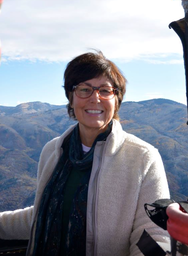 Photo: Mary Schoenherr Photo: Mary Schoenherr Mary Schoenherr: Mary has served on the ACD board for 2 years. She played a major role in seeking millage funds to further support the district, and she wishes to continue her work ensuring that millage funds are appropriated in support of the highest value programs and projects across all of Antrim County. Mary has lived in Antrim County for 6 years, and has 25+ years of experience with tech companies, filling multiple roles in organizational design and development, sales, operations, and consulting. August is National Forest Pest Awareness Month - what a great time to educate ourselves about what pests are impacting Antrim County’s trees.
The Emerald Ash Borer was detrimental to Ash trees over the past decade or so. With an estimated <5% of living Ash trees left in the County, these dead/dying trees now pose serious hazards to hikers, roadside power lines, and even your roof. Be proactive and have these trees removed before they cause damage. Now, let’s look at some forest pests that are currently in Antrim County: Beech Bark Disease, targeting Beech trees, is caused by both a sap-feeding scale insect and a fungus. As the scale feeds, the fungus is introduced and kills the wood, blocking the flow of sap. Diseased Beech trees are characterized by white patchiness; these trees decline in health and eventually die. Some infected trees break off in heavy winds before dying – a condition called "beech snap". What can you do? Watch for signs of beach bark disease, report your findings, have infected trees removed, and keep an eye out for resistant trees. Forest Tent Caterpillars are another pesky forest pest that are on the rise. The caterpillar outbreaks occur every 10-15 years, impacting Northern Hardwood forests – noticeably in the Eastern part of Antrim County. These forest pests alone are not likely to cause fatality. However, in combination with other stressors (i.e. late spring frost, lack of water, etc.) a tree may be stressed until the point of no recovery. Notice these pesky caterpillars in your backyard? Ensure your tree receives ample water during the growing season. The weather plays an obvious role in the growth and behavior of trees, which may show similar symptoms as forest pests such as early leaf drop or yellowing. This past abnormal winter combined with recent heat waves have wreaked havoc on local trees. Many of the Douglas Firs throughout the region have experienced “winter burn”- a browning on the tips of evergreen foliage. Winter burn is attributed to a lack of water, where the winter sun and wind dry out the needles. However, it’s important to note that impacted evergreen trees may very well be alive but have suffered great damage. Not all is lost. Keep in mind our forests are dynamic and ever-changing! The forests continue to evolve with each pest epidemic – wildlife and understory plant species benefit from declining trees and canopy openings. Knowing symptoms of decline can help prevent the spread of forest pests and diseases. Are you an Antrim County landowner concerned about a tree on your property? Call our District Forester to schedule a tree health assessment free of charge to you! With the official start of summer in full swing, many of us are out enjoying our County’s most valued natural resources whether it be fishing, boating, hiking, camping, or trail riding. Recreation is often the gateway for people to care and learn more about our natural resources. Keeping those natural resources healthy for all of us to enjoy now and in the future is heavily dependent upon recreating sustainably! Let’s take a look at some ways we can protect natural resources while we recreate. While hiking along a trail, invasive species can hitch a ride on the bottom of your boots, your gear, your clothing, and even your pet! Invasive species are a major threat to our local native plant and wildlife species. To avoid the spread of invasive species into an area, utilize all boot brush stations, follow firewood rules, and clean off your gear before entering a new area – this applies to the water too! Aquatic invasive species are easily moved from one body of water to the next by boaters. Incorporating Clean, Drain, Dry into your boating routine can significantly help the spread of aquatic invaders, keeping the lake fun to swim, fish, and boat in! Another sustainable practice to follow, is simply Leave No Trace – which encompasses the idea of “take only photographs and leave only footprints”. Next time you hit the trail or are out camping, remember to pack OUT what you pack IN, including your trash. This July join the Antrim Conservation District and the CAKE CISMA as we each host local events to promote sustainable recreation! The CAKE CISMA, an invasive species management group for our local region, will be hosting two boat wash stations on July 22nd to spread awareness of aquatic invaders, and to also assist boaters with the Clean, Drain, Dry practice. The Antrim Conservation District, along with our partners, will host the Jordan River Clean Sweep on July 28th to enjoy a day on the river while removing trash along the water trail. Check out these links to learn more about sustainable recreation: Leave No Trace Don't Move Firewood and Firewood: Buy It Where You Burn It Clean Drain Dry (view video below) |
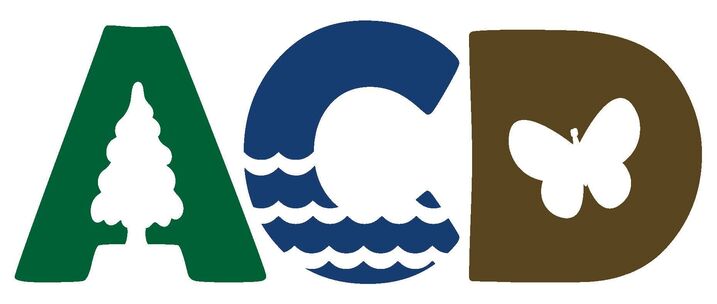

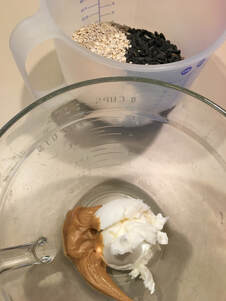
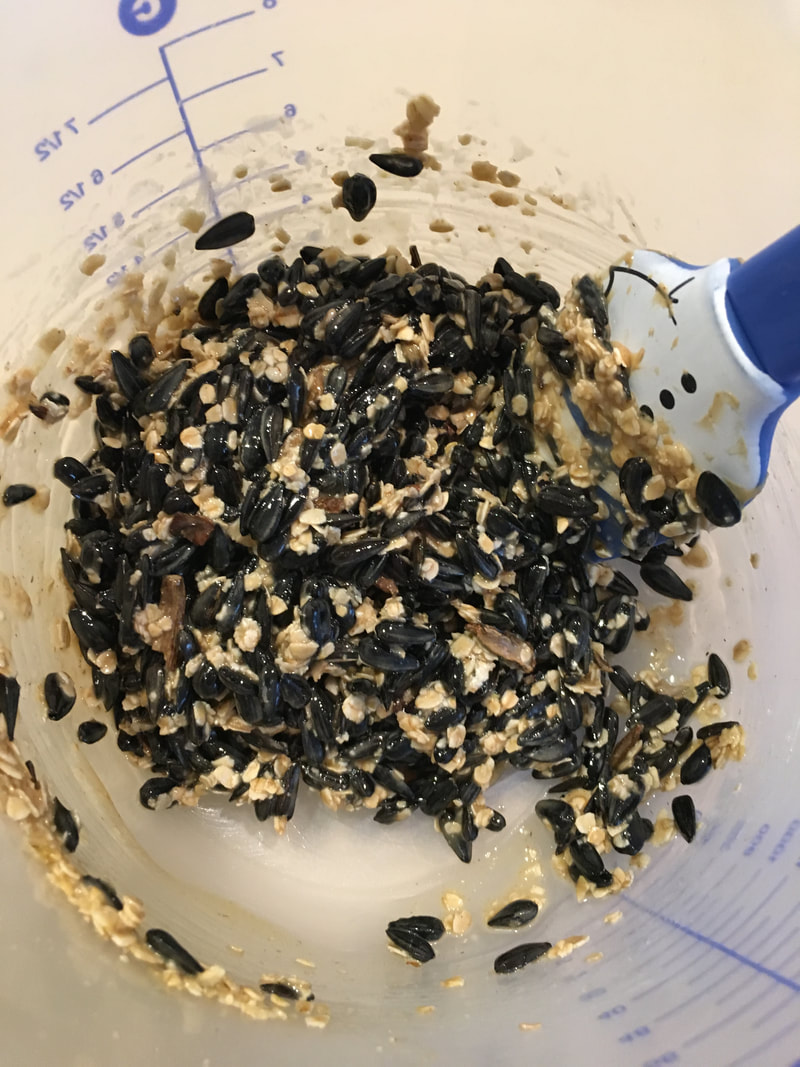
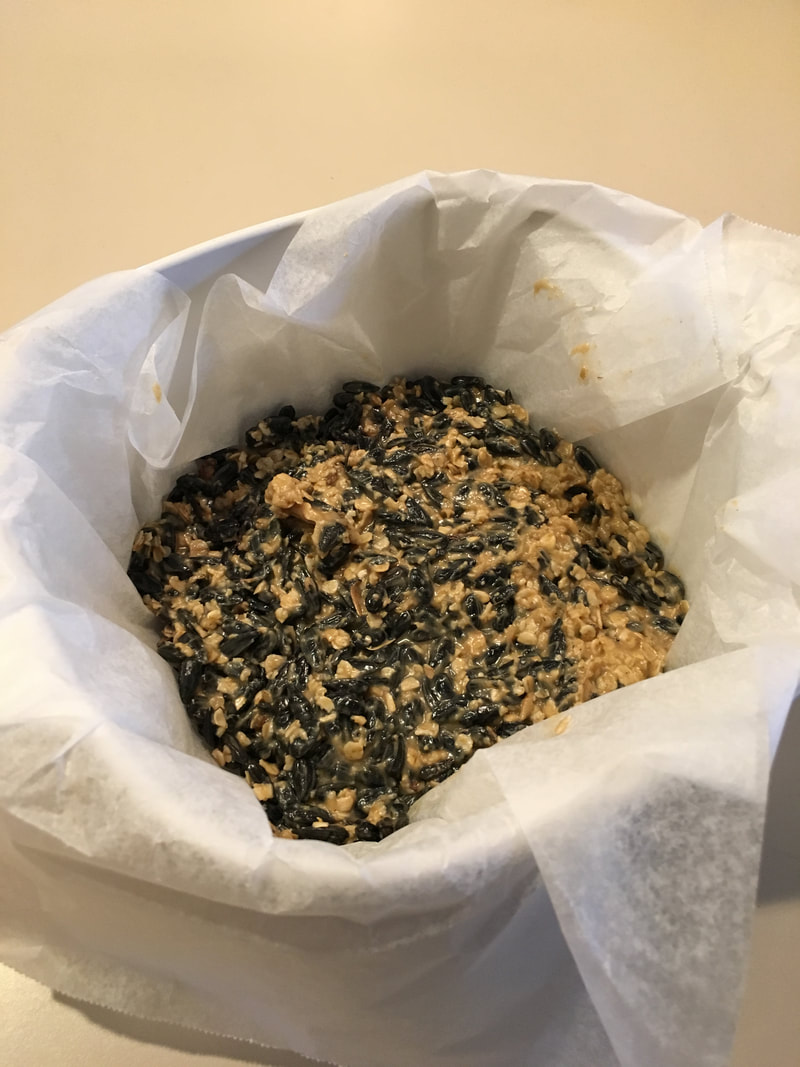

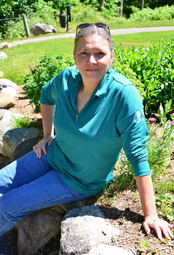
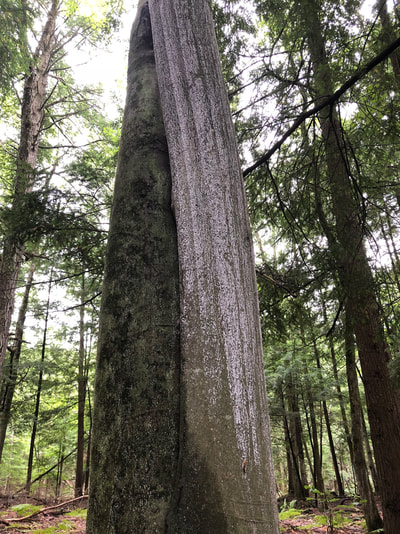
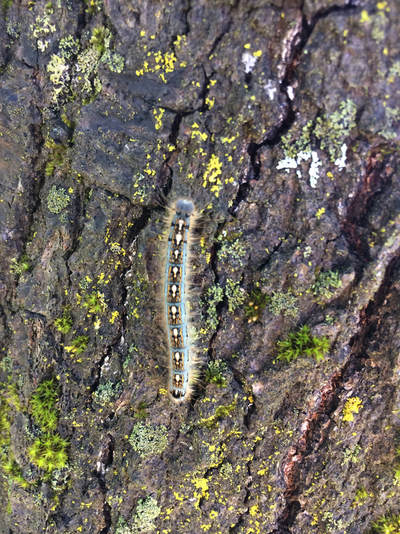
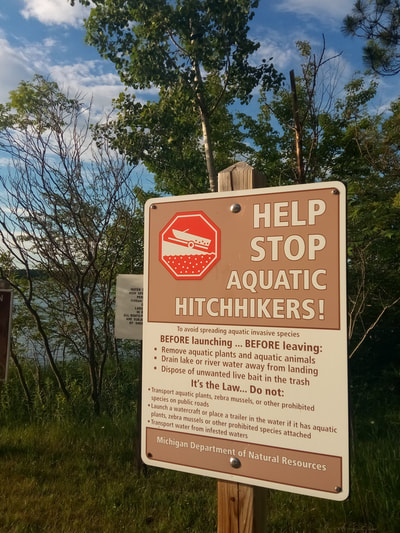
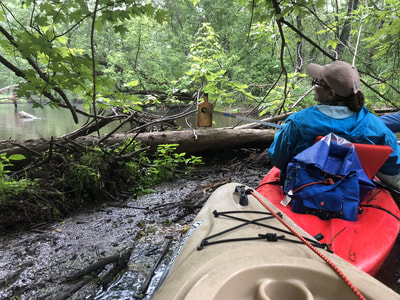

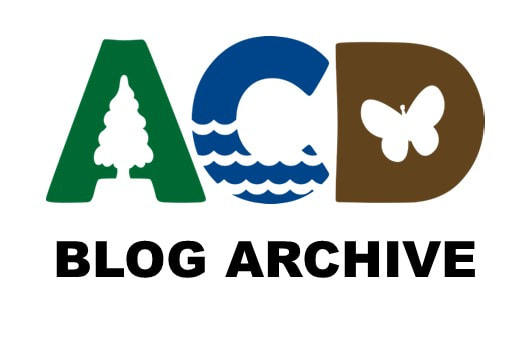
 RSS Feed
RSS Feed